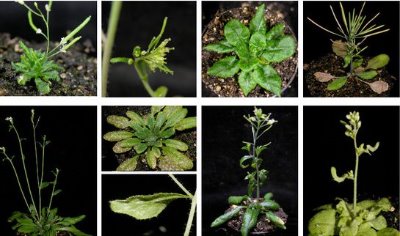Feb. 16, 2007 Research Highlight Biology
Using FOX to hunt for gene function
Researchers develop a new technique for understanding genomes
 Figure 1: Examples of the range of mutants produced by the FOX system after two generations.
Figure 1: Examples of the range of mutants produced by the FOX system after two generations.
Molecular biologists from RIKEN and two Japanese universities have developed a new system for rapidly determining the function of individual genes in plants.
The method is based around creating transgenic Arabidopsis thaliana plants by adding an extra copy of a single gene external to the chromosomes. It has been dubbed the FOX—Full-length cDNA Over-eXpressing gene—hunting system by the research team. The protein products of the extra genes modify the plants by adding to the metabolic activity of their cells. Already, the researchers have used their technique to gain information about two genes that cause changes in leaf color.
The FOX hunting system provides an alternative to the two conventional techniques of investigating gene function—knocking out or activating individual genes within the chromosomes in situ.
In a recent paper in The Plant Journal 1, the researchers describe how they used RIKEN’s collection of full-length DNA copies of about 10,000 individual Arabidopsis genes to develop their technique. They normalized this library—that is, ensured there were equal numbers of each gene copy—and introduced them back into Arabidopsis plants together with genetic material to ensure they were expressed. The transgenic plants were grown for two generations and monitored for mutants in various categories, such as shape, leaf color and fertility. The introduced DNA was then able to be recovered from the mutants and analyzed to determine which gene caused which changes.
During the course of their development work, the researchers created more than 15,000 fertile plant lines (Fig. 1). They also carried out a series of tests to screen the progress and efficiency of their new technique.
The group undertook a detailed study of two light-green leaf-color mutants to see how much information on the function of individual genes their new technique could provide. They were able to extract, sequence and classify the genes responsible for the changes, as well as match them to variations in plant structure, growth and form. In one case the gene selected affected the development of chloroplasts and subsequent photosynthetic activity; in the other, while the precise role of the gene remained a mystery, it was clearly important as preventing it from functioning tended to be lethal.
“The ultimate goal of our work is to improve plants by introducing genes from other organisms,” says team leader, Minami Matsui from RIKEN’s Plant Science Center in Yokohama. “Using such genes, you can add new functions to plants that have never been achieved by conventional breeding.”
References
- 1. Ichikawa, T., Nakazawa, M., Kawashima, M., Iizumi, H., Kuroda, H., Kondou, Y., Tsuhara, Y., Suzuki, K., Ishikawa, A., Seki, M., Fujita, M., Motohashi, R., Nagata, N., Takagi, T., Shinozaki, K. & Matsui, M. The FOX hunting system: an alternative gain-of-function gene hunting technique. The Plant Journal 48, 974–985 (2006). doi: 10.1111/j.1365-313X.2006.02924.x
